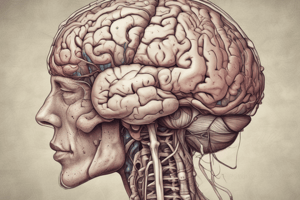Podcast
Questions and Answers
What is the main function of the cerebral cortex?
What is the main function of the cerebral cortex?
- Processing sensory information (correct)
- Forming emotional responses
- Regulating body temperature
- Controlling voluntary movements
Which structure relays sensory information to the cortex?
Which structure relays sensory information to the cortex?
- Cerebral cortex
- Hypothalamus
- Basal ganglia
- Thalamus (correct)
What is the function of the hypothalamus?
What is the function of the hypothalamus?
- Processing sensory information
- Controlling voluntary movements
- Forming emotional responses
- Regulating body temperature, hunger, and thirst (correct)
What is the purpose of the blood-brain barrier?
What is the purpose of the blood-brain barrier?
What is the function of the brainstem?
What is the function of the brainstem?
What is the purpose of the meninges?
What is the purpose of the meninges?
Flashcards are hidden until you start studying
Study Notes
Brain
Structure
- Cerebrum: largest part of the brain, divided into two hemispheres (left and right)
- Cerebral cortex: outer layer of the cerebrum, responsible for processing sensory information
- Basal ganglia: group of structures involved in movement and cognition
- Thalamus: relays sensory information to the cortex
- Hypothalamus: regulates body temperature, hunger, and thirst
- Brainstem: connects the cerebrum to the spinal cord, responsible for controlling automatic functions (breathing, heart rate, etc.)
Functions
- Motor control: cerebrum and basal ganglia work together to control voluntary movements
- Sensory processing: cerebral cortex processes sensory information from the environment
- Cognitive functions: cerebrum involved in attention, memory, language, and problem-solving
- Regulation of bodily functions: hypothalamus and brainstem regulate body temperature, hunger, thirst, and other automatic functions
- Emotional processing: limbic system (includes hippocampus, amygdala) involved in emotional responses and memory formation
Blood Supply
- Blood-brain barrier: specialized barrier that separates the brain from the bloodstream
- Cerebral arteries: supply oxygenated blood to the brain
- Cerebral veins: drain deoxygenated blood from the brain
Protection
- Skull: bony structure that protects the brain
- Meninges: protective membranes that cover the brain and spinal cord
- Cerebrospinal fluid: clear fluid that cushions the brain and spinal cord, provides buoyancy and protection
Brain Structure
- The cerebrum is the largest part of the brain, divided into two hemispheres (left and right)
- The cerebral cortex is the outer layer of the cerebrum, responsible for processing sensory information
- The basal ganglia is a group of structures involved in movement and cognition
- The thalamus relays sensory information to the cortex
- The hypothalamus regulates body temperature, hunger, and thirst
- The brainstem connects the cerebrum to the spinal cord, controlling automatic functions like breathing and heart rate
Brain Functions
- The cerebrum and basal ganglia work together to control voluntary movements
- The cerebral cortex processes sensory information from the environment
- The cerebrum is involved in attention, memory, language, and problem-solving
- The hypothalamus and brainstem regulate body temperature, hunger, thirst, and other automatic functions
- The limbic system (including the hippocampus and amygdala) is involved in emotional responses and memory formation
Blood Supply and Protection
- The blood-brain barrier separates the brain from the bloodstream
- Cerebral arteries supply oxygenated blood to the brain
- Cerebral veins drain deoxygenated blood from the brain
- The skull is a bony structure that protects the brain
- The meninges are protective membranes that cover the brain and spinal cord
- Cerebrospinal fluid cushions the brain and spinal cord, providing buoyancy and protection
Studying That Suits You
Use AI to generate personalized quizzes and flashcards to suit your learning preferences.




